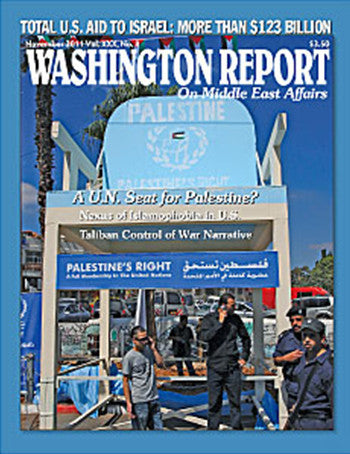
WASHINGTON REPORT
With roots thousands of years old, Palestinian costume is a rich tradition that evolved over time to form through color and pattern a visual language revealing the wearer's heritage, ancestry, and affiliations. During the 1948 Nakba, however, Jewish and then Israeli forces demolished hundreds of Palestinian villages and towns (see p. 38) and dispossessed hundreds of thousands of their residents, disrupting centuries-old textile trading networks and threatening to extinguish altogether this vibrant practice. Indeed, by the 1950s many fabrics produced specifically for the Palestinian market had disappeared forever, and local styles went into decline.
When the 1967 war forced even more Palestinians from their homes and into refugee camps, much of what remained of the traditional textile industry collapsed. For many Palestinians, the war and its aftermath made clear the need to preserve their culture as a way to affirm national identity and maintain their attachment to their land. Despite the odds, traditional embroidery practices were reborn in the refugee camps. Embroidery produced in refugee camps in Lebanon, Jordan, the West Bank and Gaza not only helped provide many families with a stable income, but grew into one of the most enduring foundations of Palestinian cultural heritage.
Hanan Munayyer's Traditional Palestinian Costume and Threads of Identity by Widad Kawar represent vital contributions toward the preservation and documentation of traditional Palestinian costume. Both books contain hundreds of beautiful glossy color photos from two of the world's largest collections of traditional Palestinian costume. Each also explores in a distinct way the history of Palestinian costume.
Beginning in the mid-1980s, Munayyer and her husband, Farrah, took out a home equity loan and bought more than 65 traditional dresses from a Jerusalem antiques dealer. Following further acquisitions, the couple committed themselves to promoting Palestinian art and culture eventually founding the Palestinian Heritage Foundation. It was while doing research in 1987 for a documentary film that could be disseminated to educational institutions, libraries and individuals that Munayyer began to piece together a history of costumes and crafts in the Middle East spanning more than 4,000 years.
The result of more than 23 years of research, Traditional Palestinian Costume is not only a sizeable book brimming with beautiful multi-page color photos, but an invaluable resource for students and admirers of Palestinian culture. The book's first section, which explores the origins of Palestinian costume, represents the most comprehensive study of its kind. Combining recent archeological discoveries with original research, Munayyer traces the origin of the motifs found in Palestinian costume and jewelry by analyzing ancient engravings, carvings and other artifacts dating as far back as the 11th century BC. Subsequent sections cover regional variations and historical contexts. This reviewer shares the Munayyers' hope that visitors one day will be able to view these pieces in a museum.
Threads of Identity offers a more intimate look at the preservation of Palestinian embroidery by focusing on author Kawar's own story, as well as the personal histories of the women who created the pieces in her collection. Considered one of the foremost authorities on the subject, Kawar interviewed embroiderers from Bethlehem to Gaza, and from Ramallah to the Bedouin tribes of the Naqab. Each section of the book focuses on a specific region, presenting historical research as well as personal stories and striking images.
Kawar's own story is as fascinating as those of the women she interviews. Born in the Nablus area of the West Bank, Kawar returned from her studies at the American University of Beirut in 1950 to find her homeland devastated by the Israeli occupation. As a student of Arab history and sociology, she became convinced that she needed to preserve the Palestine of her childhood by collecting costumes and information about them from their owners. After moving to Amman with her husband, she traveled often to the West Bank and to refugee camps in Jordan, purchasing costume pieces and listening to the women's stories.
To Kawar, each textile represents a woman's life, its aesthetic value inseparable from its human history. In a particularly powerful passage, she describes her reaction at a party in which wealthy Palestinians and foreign women were dressed in newly purchased traditional Palestinian costumes. Refugees recently dispossessed from their rural villages by the 1967 war had sold many of the dresses, normally kept as family heirlooms, in an effort to support their families. "The costumes appeared to me as ghosts," Kawar writes, "separated from their original owners by tragedy. Such experiences made me realize the urgency of preserving the traditional costumes and spurred me on to expand my endeavors to collect." Both Munayyer's and Kawar's works are testaments to their devotion to help reassert Palestinians' national identity and their right to freedom, dignity and independence.
Reviewed by Andrew Stimson
Washington Report for Middle Eastern Affairs
November 2011 issue, page 70 - Books


